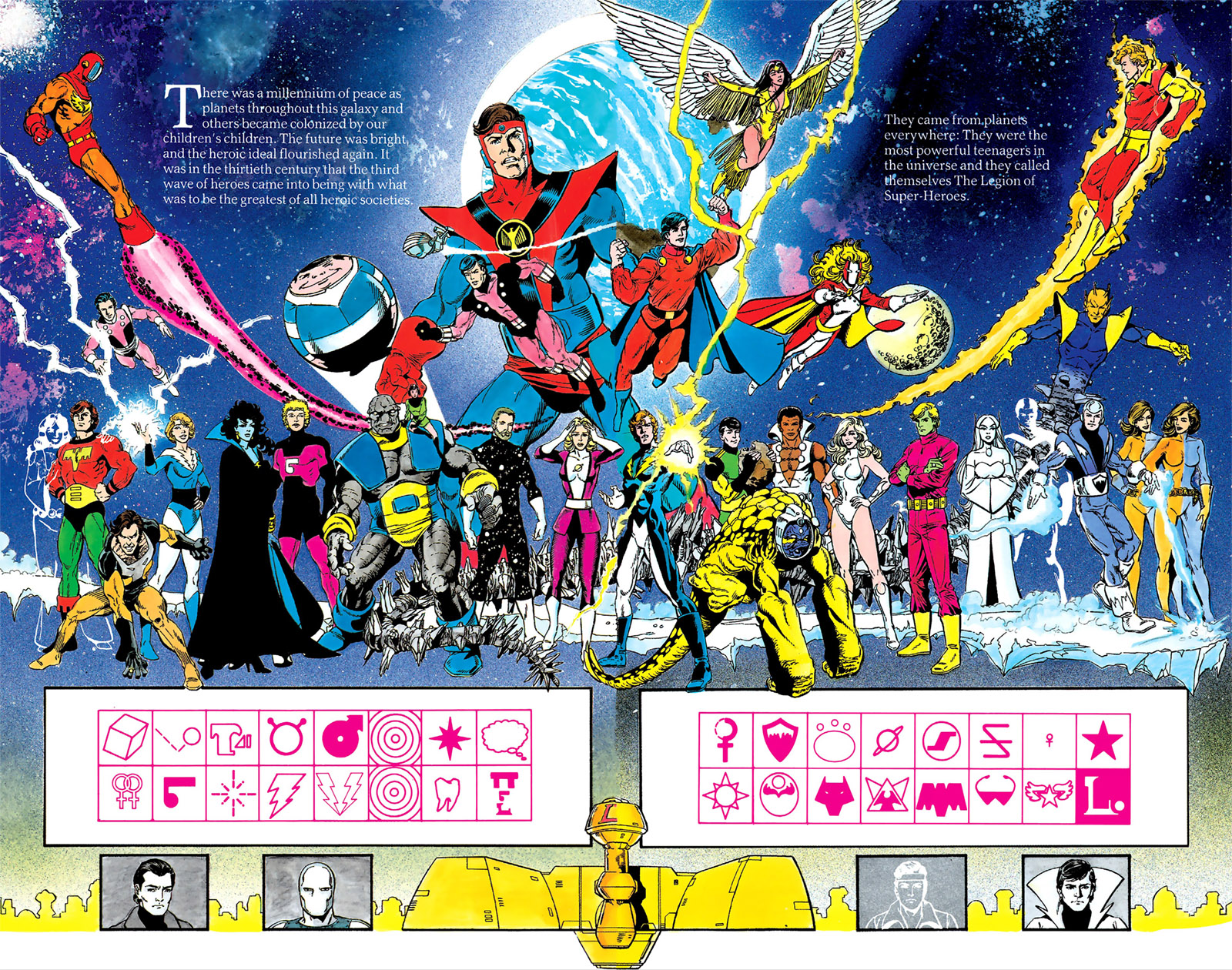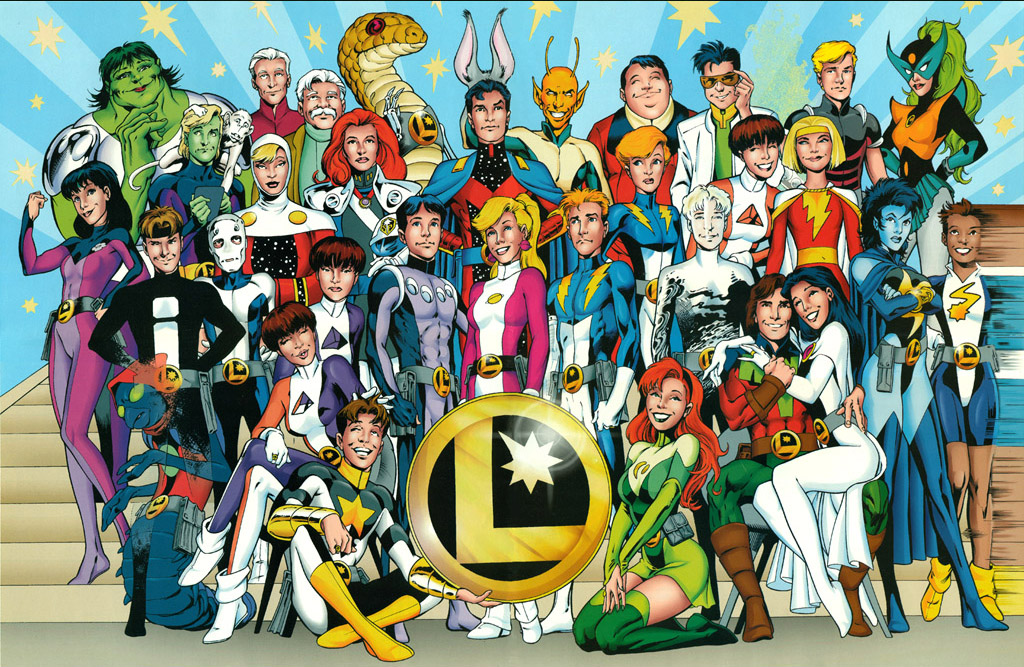LEGION OF SUPER-HEROES
Legion of Super-Heroes: An Introduction
The Legion of Super-Heroes is a large group of teen heroes whose adventures take place one thousand years in the future!
The Legion's first appearance was like any other Silver Age Superboy (or Superman) story: freewheeling. In Adventure Comics #247 (April 1958), three super-teens invited the teenage Superboy to join their "club." Something about these heroes resonated strongly with fans and they sparked continued interest.
In Adventure Comics #364 (Jan. 1968) DC editors even encouraged fans to vote for the next Legion leader (the results appeared in Adventure #368). The team's popularity eventually led to their independence from the Boy of Steel.
The Legion's membership numbers in the dozens, and its supporting cast is enormous. The diversity of the Legion universe gives creators a broad canvas to explore the characters' personalities and relationships. Unlike many other DC teen heroes (like the Teen Titans), the Legionnaires are not sidekicks but have always operated more-or-less autonomously, despite their ages.
The Legion resides in the future, so events that happen in the current-day DC Universe frequently have ripple effects on the Legion's reality. There have been several distinctly different Legions, each borne from a DC Comics "crisis event."
Eras in Legion Continuity
Cosmic Teams organizes the Legions of the DC universe in the following way:
The Original Legion (1958–1994)
Created by Otto Binder and Al Plastino
»
FIRST APPEARANCE: Adventure
Comics #247 (Apr. 1958)

The Original Legionnaires debuted in a Superboy story from Adventure Comics #247 (April 1958). Superboy (Superman as a boy) became a member of the team, as well as his cousin, Supergirl (who actually preceded him in joining).
The Original Legion was published through 1994, though its continuity did undergo some major continuity shifts in 1986 and 1989. These were not so-called "hard reboots," but instead aimed to redefine (or minimize) the Legion’s connections to Superboy/Superman. After the Crisis on Infinite Earths, Superman was remade so that he had never been Superboy, and Supergirl did not exist. This necessitated a series of "retcons" and eventually led to the Glorith Reality, which didn't rely on the Super-cousins at all.
» SEE: The Original Legion: Introduction
Key Comic Book Series
- Adventure Comics #300–380 (1962–69)
- Action Comics, #378–392 (1969–70)
- Legion of Super-Heroes vol. 1, 4 issues (1973)
- Superboy (and the Legion) #197–258 (1974–79);
becomes ...
- Legion of Super-Heroes vol. 2, #259–313 (1980–84); becomes …
- Tales of the Legion of Super-Heroes, #314–354 (1984–87)
- Secrets of the Legion of Super-Heroes, 3-issue limited series (1981)
- Legion of Super-Heroes vol. 3, 63 issues (1984–94)
- Legionnaires Three, 4-issue limited series (1986)
- Cosmic Boy, 4-issue limited series (1986)
- Who’s Who in the Legion of Super-Heroes, 7-issue limited series (1988)
- Legion of Super-Heroes vol. 4, #1–61 (1989–94)
- Valor, 23 issues (1992–94)
- Timber Wolf, 4-issue limited series (1992)
The SW6 Legion (1991–1994)
Created by Keith Giffen, Mary Bierbaum and Tom Bierbaum
»
FIRST APPEARANCE: Legion of Super-Heroes vol. 4 #20 (July 1991)

The Legionnaires from "Batch SW6" were part of Original Legion continuity. In Legion vol. 4 #53 (Jan. 1994), it was learned that years before, the Legionnaires had been 'copied' by the Time Trapper ("Batch SW6" was the label on the chamber in which they were kept). These youthful duplicates were kept in storage and literally unearthed during the planet's fight for freedom against the Dominators.
» SEE: The SW6 Legion
Key Comic Book Series
- Legionnaires #1–18 (1993–94)
The Reboot Legion (1994–2004)
Created by Tom McCraw, Mark Waid and Stuart Immonen
»
FIRST APPEARANCE: Legion of Super-Heroes #0 (Oct. 1994)

The Reboot Legion was created during Zero Hour: Crisis in Time, when the Original Legion ceased to exist. The future was totally "rebooted." Later, this reality was designated as Earth-247.
» SEE: The Reboot Legion: Introduction
Key Comic Book Series
- Legion of Super-Heroes vol. 4, #0, 62–125 (1994–2000)
- Legionnaires, #0, 19–81 (1994–2000)
- Legends of the Legion, 4-issue limited series (1998)
- Legion: Lost, 12-issue maxi-series (2000–01)
- Teen Titans/Legion: Universe Ablaze, 4-issue limited series (2000)
- Legion Worlds, 6-issue limited series (2001)
- The Legion, 38 issues (2001–2004)
- Final Crisis: Legion of Three Worlds, 5-issue limited series (2008-09)
The Threeboot Legion (2004–2009)
Created by Mark Waid and Barry Kitson
»
FIRST APPEARANCE: Titans/Legion Special (Nov. 2004)

The "Threeboot" was the second hard reboot of the Legion franchise. They were later designated the Legion of Earth-Prime. This timeline was created by events surrounding the Infinite Crisis.
» SEE: The Threeboot Legion: Introduction
Key Comic Book Series
- Legion of Super-Heroes vol. 5, #1-14, #37-50 (2005–09)
- …retitled Supergirl and the Legion of Super-Heroes #15–36
- Final Crisis: Legion of Three Worlds, 5-issue limited series (2008-09)
Retroboot (2006–2010)
Created by Geoff Johns and Gary Frank
» FIRST APPEARANCE: Justice League of America vol. 2 #8 (June 2007)

The Legion Retroboot is a version of the team that is very similar to the Original Legion. It was more-or-less restored by the Infinite Crisis. The Retroboot's continuity includes Original continuity — minus the events of Legion volume 4 (1989–94; called the "Glorith Reality" here).
The origin of the Retroboot Legion was retooled a little in Legion: Secret Origin and Adventure Comics vol. 3. They starred in new adventures in Legion of Super-Heroes vol. 6 (2010).
This version of the team also includes the "New 52" era (2011–2019). However, Legion continuity became fraught with new continuity problems after the launch of the New 52. This timeline was supplanted by the creation of the Rebirth Legion.
» SEE: The Retroboot Legion: Introduction
Key Comic Book Series
Retroboot continuity includes the Original Legion series above, plus:
- Final Crisis: Legion of Three Worlds, 5-issue limited series (2008-09)
- Adventure Comics #1–11 [504–510], 511–529 (2010–11)
- Legion of Super-Heroes vol. 6, 16 issues (2010–11)
- Legion: Secret Origin, 6-issue limited series (2011–12)
- Legion: Lost vol. 2, 17 issues (2011–13)
- Legion of Super-Heroes vol. 7, 23 issues (2011–13)
Rebirth Legion (2019–present)
Created by Brian Michael Bendis and Ryan Sook
» FIRST APPEARANCE: Superman vol. 5 #14 (Oct. 2019)

The fourth distinct version of the Legion was the brainchild of Brian Michael Bendis and Ryan Sook. It came about later in the wave of DC's "Rebirth" initiative (which was begun in 2016). In the Metaverse following Rebirth, Superman's son — Jon Kent — joined the Legion as Superboy. The creation and existence of the Rebirth Legion was explained in Doomsday Clock #10–12 (July 2019–Feb. 2020). They first appeared in Superman vol. 5 #14 (Oct. 2019).
» SEE: Rebirth Legion
Key Comic Book Series
- Legion of Super-Heroes: Millennium, 2-issue limited series (2019)
- Legion of Super-Heroes vol. 8, current (2019–)
The Animated Legion

The Legion guest-starred in several animated series (which did not necessarily share continuity) before landing their own self-titled series for two seasons. This Legion could possibly reside in the "DC animated" universe, Earth-12. There was a cartoon comic book published at the same time.
» SEE: The Animated Legion
Key Series
- Legion of Super-Heroes animated series, 2 seasons (2006–08)
- Legion of Super-Heroes in the 31st Century, 20 issues (2007–09)
L.E.G.I.O.N.
Created by Keith Giffen, Todd McFarlane, Alan Grant and Barry Kitson
» FIRST APPEARANCE: Invasion! #1 (1988)

The group known as L.E.G.I.O.N. is a 20th/21st century group that operates at large in the galaxy. Some of their members are the ancestors of future Legionnaires (such as Brainiac 5 and Blok). Their group escaped from Dominator captivity and organized themselves into galactic peacekeepers.
» SEE: The L.E.G.I.O.N and R.E.B.E.L.S.
Key Comic Book Series
- L.E.G.I.O.N., 70 issues (1989–94)
- R.E.B.E.L.S. vol. 1, 17 issues (1994–96)
- R.E.B.E.L.S. vol. 2, 28 issue (2009–11)
Other versions
There are lots of crazy alternate versions of the Legion. Read Legion "Elseworlds" to learn more. Most of these tales were purposely noncanonical. In the Silver Age of comics, these kinds of variant stories were sometimes called "Imaginary Stories."
Visual Guides



Aside from diving right into one of the Legions above, you might like to absorb some images that can help you differentiate between the Legions:
- At-a-Glance Cross-Legion Comparison provides a visual guide to the most common Legionnaires in the major universes
- The Legion Gallery is organized by Legion versions.
Publication History
How to start reading? DC Universe has almost all of the Legion's history available to subscribers. Certain eras are well-collected in trade paperbacks. See the Publications section for a list of trade paperbacks and others.
» SEE ALSO: Legion in Print
Cosmic Collaborators
The following is the most complete Legion of Super-Heroes Chronology ever compiled. It was originally written by myself, but major additions and edits were made by John Censullo. More edits were performed by Aaron Severson, and the Reboot material by Brian Mendus. It has been great fun to work with these guys and their material is superior my own work here.
» SEE ALSO:
- John Censullo wrote a lot of the Obscure Characters.
- Aaron Severson also wrote the Pocket Universe Primer, the Golden Age Batman material, and contributed to countless other Profiles.